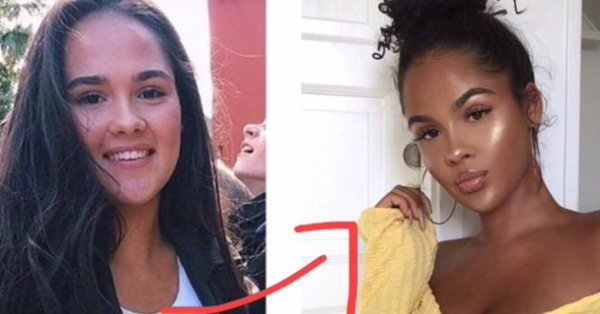15 October 2019
Country: Global
by: Sofia Ferreira Santos

 By now, most of the world can agree that “Blackface” is racist and wrong. But what about blackfishing?
By now, most of the world can agree that “Blackface” is racist and wrong. But what about blackfishing?
Derived from the term “catfishing”—Internet slang for pretending to be someone you are not online—“blackfishing” refers to the growing practice of white social media influencers using self-tanner, makeup and plastic surgery to project a black, or mixed race aesthetic online. As we celebrate Black History Month, it is important to investigate how this relatively recent phenomenon is capitalising on black culture, while completely disregarding black history.
It is no secret that online influencing is becoming a more and more lucrative profession; however, instead of following traditional standards of beauty that dictate the perfect woman as a skinny white blonde, apps like Instagram have allowed communities of colour to carve out a space for ourselves, sharing our own ideas of beauty online. We have been able to create our own online communities of positivity and support that prioritise our cultures, like the infamous ‘black Twitter. These communities subvert traditional societal hierarchies by placing the needs and wants of people of colour first. But with the rise of POC communities and its influencers, certain white influencers have begun to realise that there is a whole audience within popular social media circles that is not centered around them. As a result, some of these influencers are starting to sport cultural items like hoop earrings and headwraps, and even go as far as to alter their appearances with makeup, filters and surgeries to appear to have darker skin, curvier bodies, and curly or “Afro” hair.
Fetishising women of colour is no new phenomenon, but white women physically altering their bodies to trick social media users to like their posts brings it to a whole new level. Instagram’s features like filters and photo editors, allow this phenomenon to flourish—but as a photography-based social media platform, it is also a space where this can be debunked. Last year, some of popular Instagram influencer Emma Halberg’s followers dug up old pictures of her, revealing that the nineteen-year-old model—who appears to have long curly black hair, dark skin, and is frequently celebrated for being a Black role model—is actually white. While there was an uproar amongst some of her following who felt that they had been deceived, the model claimed that she just had a “really dark tan” and continues posting to this day.
The problem with blackfishing is not only cultural appropriation—though that is a huge part of it. It is also that the white women who engage in blackfishing do so little to address or change how black women are routinely ridiculed for naturally having the same aesthetic and belonging to the same culture that they are ignorantly copying. Now that we have finally managed to empower ourselves in a society that is ruled by white supremacy, our culture is being commodified into another way for white women to dress up like us—all the while knowing that they can wipe off their tan, or straighten their hair when it is no longer convenient to pretend to be black.
While these women are rewarded for using makeup, surgery, filters and money to look like us, we are ridiculed, sexualised, abused and sometimes even murdered for being born with the skin colour and hair type that white women are mimicking “just for fun.” For blackfishing-white-influencers, “looking black” expands their popularity on social media, and garners them likes and followers when certain aspects of black culture are trending. If they enter a more traditional professional space, they can revert to their whiteness as a safety blanket, trying to have the best of both worlds and living different online and offline lives. We can’t do that.
In some ways, blackfishing seems like a desperate reaction from white women who have never experienced being outside of the universal beauty ideal as women of colour have experienced for a long time. However, while there is certainly a greater diversity of shapes, sizes and skin colours among models (largely amplified by social media), as women of colour we are still less likely to get hired for any job, and more likely to be arrested or killed by the police. White women, on the other hand, are still winning at the privilege game—and those that blackfish on Instagram seem like they can’t accept the fact that we are finally getting some of the recognition that we deserve.
Unlike blackface, which most can now recognise as wrong, blackfishing exists in an ambiguous space, where white women can do it with no real, lasting consequences. Emma Halberg is back to influencing even more followers, who now understand her as a white woman who simply has a “really dark tan.” However, these excuses are scapegoats for a racist reality: white women are mimicking blackness for attention, popularity and money, all the while stealing recognition from actual women of colour – and reverting all of the work, pain and sacrifice our communities have been through to get these safe spaces and keep our cultures alive.
Sofia Ferreira Santos is a Brazilian journalist living in East London. She tweets at @sofiferreiras.
Image: Emma Halberg’s “transition” from a white Swedish girl to a “black” influencer. Source: Twitter
Nenad Radoja
Contrary to popular belief, Lorem Ipsum is not simply random text. It has roots in a piece of classical Latin literature from 45 BC, making it over 2000 years old. Richard McClintock, a Latin professor at Hampden-Sydney College in Virginia, looked up one of the more obscure Latin words, consectetur, from a Lorem Ipsum passage, and going through the cites of the word in classical literature, discovered the undoubtable source.